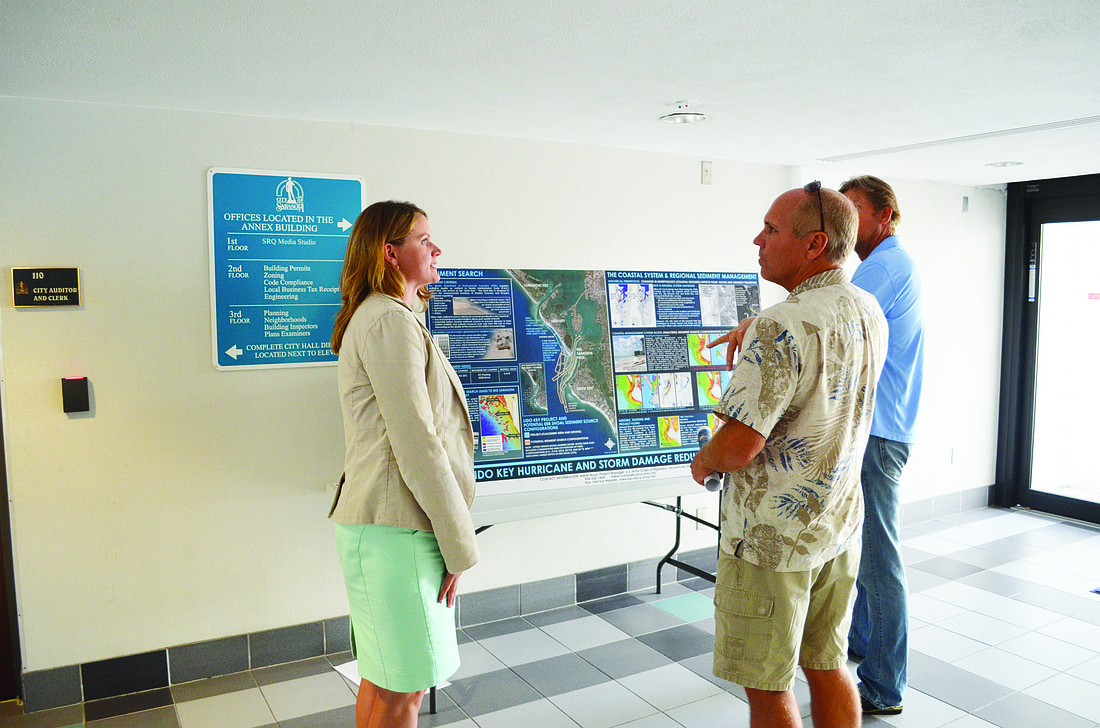- April 19, 2024
-
-
Loading

Loading

In the wake of an Army Corps of Engineers report that supports a project to renourish Lido Key with sand from Big Pass, Lido residents are beginning to rally support for the project, but Siesta Key residents remain skeptical.
On July 23, the Army Corps held a series of public meetings at Sarasota City Hall, the first such meetings since the report was released in mid-June. Corps officials made the case for the project, which would use up to 1.3 million cubic yards of sand in the first-ever dredging of Big Pass, and took input from residents.
The Lido Key Residents Association has been passionate about this project for some time, but has avoided actively campaigning for it. Instead, the group has allowed the city — the Army Corps’ partner on the dredging project — to take the lead in gathering support for the proposal.
The city did do some lobbying for the importance of the project, with City Manager Tom Barwin calling Lido Key an essential economic tool for the region. He also emphasized the importance of adhering to environmental standards and protecting adjacent shorelines, assuring attendees that the process for gaining approval is rigorous.
“This project has been reviewed, will continue to be reviewed, will be peer reviewed,” Barwin said. “I don’t think we’ll move forward until we’ve got it right.”
With the report out, however, Lido residents were more forceful about stressing the urgency of the project, which would replenish critically eroded portions of the shoreline.
“The 800 members of the Lido Key Residents Association are in complete agreement,” association President Carl Shoffstall said. “We would like to see this project move forward with the Army Corps.”
Siesta Key residents, concerned about what effects dredging Big Pass might have on the Siesta shoreline to the south, remained wary of the project despite the Army Corps report. Attendees at last week’s meetings were not as adamantly opposed to the dredging as they had been at an earlier Army Corps presentation in December, but residents felt questions about the future of Siesta Key remained unanswered.
Peter van Roekens, a Siesta Key resident, is a member of the group Save our Siesta Sand 2, which is fighting against the dredge of Big Pass. Van Roekens said an independent peer review was necessary to confirm that the risk to Siesta was negligible before the project can move forward. Sarasota County commissioners have discussed funding a peer review of the dredging project.
“Before anything happens in terms of dredging Big Pass for the first time, we need to have a truly independent peer reviewer look at their plan,” van Roekens said. “The fact is, nobody who’s independent has looked at it.”
Van Roekens said the Army Corps was doing a good job of selling the merits of the project for Lido Key, but that the report didn’t give enough certainty to justify putting such an essential economic engine — Siesta Beach and the rest of the Key — at risk.
“This is not a sales job — these are not parking meters you’re going to put in and take out,” van Roekens said. “This is a major, major project.”
Although some residents are still unconvinced, Corps officials tried to quell specific concerns about the project. In response to a question about the total amount of sand to be added to the Lido Shoreline over the 50-year lifespan of the project — a figure that comes to 6.6 million cubic yards — Coastal Engineer Jason Engle explained that some sand would come from New Pass, while Big Pass would be naturally replenished over time with the sand added to Lido.
“About 2.3 million cubic yards have accumulated in the Big Sarasota Pass ebb shoal in the past 10 years,” Engle said. “It’s unlikely that we would be reducing it by much more than that.”
The Army Corps is in the process of applying for state permits and making sure the proposed project complies with national environmental regulations. A permit is unlikely to be issued until summer 2015, and the Corps has yet to secure funding for the project. Another public meting is scheduled for November, when an environmental assessment will be available for public review.
Contact David Conway at [email protected]